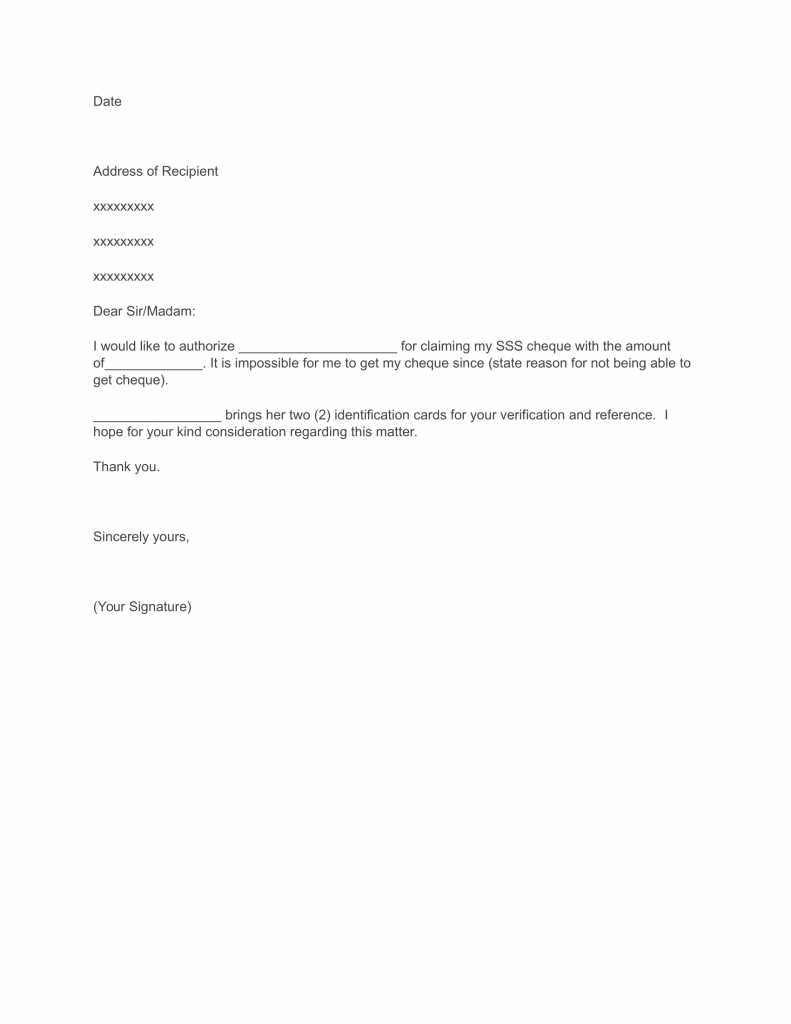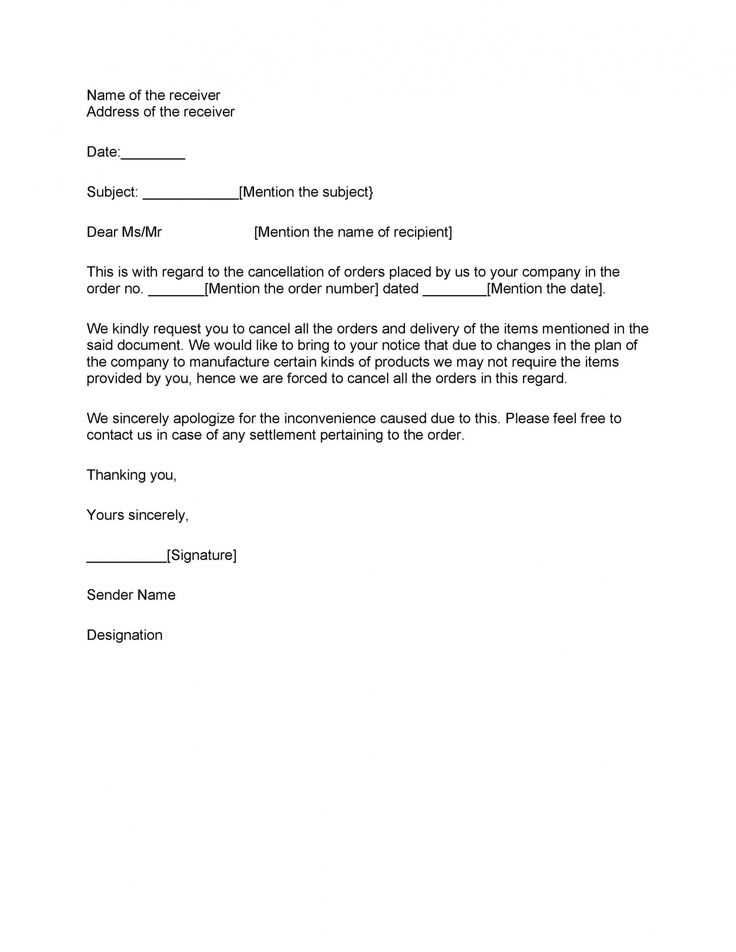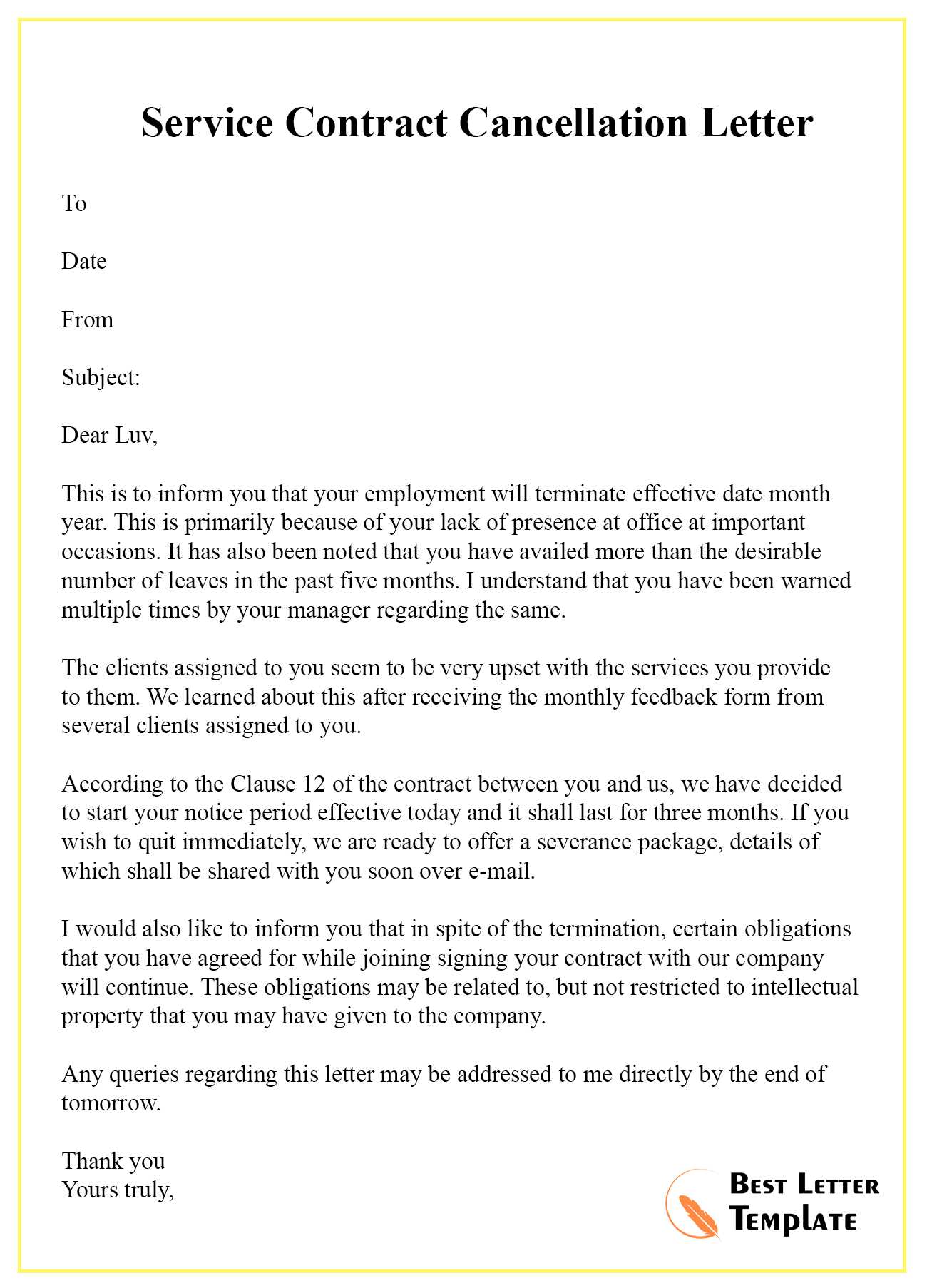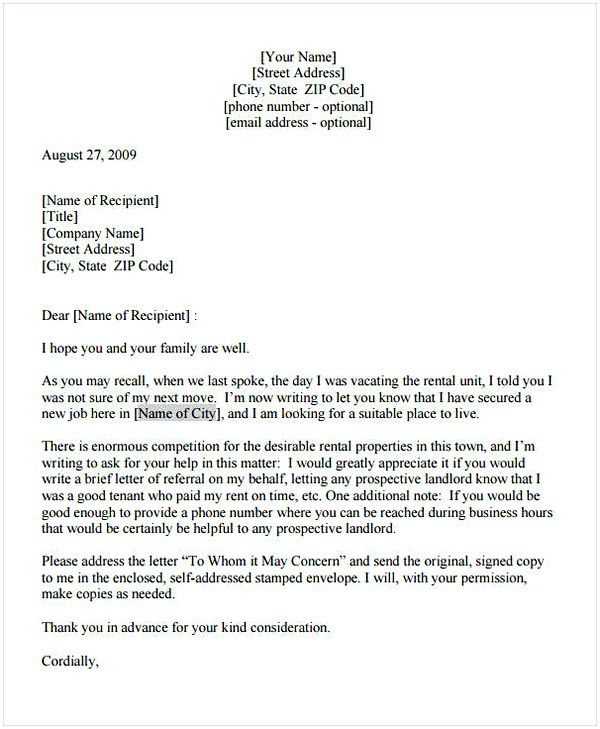Letter of Cancellation Template for Easy Use

When it comes to formal correspondence, having a clear and concise document to communicate intentions is crucial. Whether you are ending a service, canceling a contract, or withdrawing from an agreement, crafting a well-structured notice can help ensure your message is received and understood without ambiguity.
Knowing the right format and language to use can make a significant difference in how your message is perceived. This guide will walk you through the essential components and provide helpful tips to create an effective and professional document that communicates your purpose with clarity.
By following a structured approach, you can avoid common pitfalls and ensure your notice serves its intended function, whether in business, personal, or legal contexts.
Guide to Crafting a Formal Notice

Creating a formal written communication for withdrawing from an agreement or terminating a service is an essential skill. This type of document should be clear, concise, and to the point, ensuring that the recipient understands your intent without confusion. The key to an effective notice lies in its structure and the clarity of the message.
Understanding the Basic Structure

The document should follow a straightforward format, including the main details of your decision and relevant dates. Here are the fundamental components that should be included:
- Clear identification of both parties – Include your name and the recipient’s name, as well as their contact details.
- Reason for the action – While it is not always necessary to provide a detailed explanation, offering a brief reason can add clarity.
- Effective date – Specify the date on which the decision or termination takes effect.
- Any required instructions – If there are specific actions needed, such as returning items or fulfilling obligations, list them here.
Common Mistakes to Avoid

When drafting your document, be mindful of the following common errors:
- Vagueness – Always provide clear and precise information to avoid misinterpretation.
- Excessive detail – Avoid unnecessary explanations that could complicate the main message.
- Lack of professionalism – Keep the tone formal and respectful, even if the context involves a disagreement or frustration.
By focusing on these elements, you can ensure that your communication is effective and professionally executed, making the process smoother for both parties involved.
Why You Need a Formal Withdrawal Notice
When you decide to end an agreement or discontinue a service, having a well-structured document to communicate your decision is essential. It provides clarity and ensures that all parties involved understand the terms and timeline of the termination.
Benefits of Having a Formal Notice
Using a formal withdrawal communication offers several advantages:
- Clear Communication – It eliminates ambiguity by formally expressing your intentions in writing.
- Legal Protection – A documented record of your decision can serve as protection if any disputes arise.
- Professionalism – A well-written document maintains a professional tone, even when dealing with difficult situations.
When It Is Necessary
While some casual agreements might not require written confirmation, there are certain situations where a formal notice is crucial:
- Ending Contracts – When terminating long-term or legally binding agreements, a formal document is often required.
- Discontinuing Services – If you no longer wish to use a service, notifying the provider in writing is the most effective approach.
- Withdrawing from Subscriptions – Whether it’s a magazine subscription or an online service, formal notification ensures there is no misunderstanding.
In these cases, having a properly drafted document ensures your actions are clear, legally supported, and professionally communicated.
Key Elements of a Withdrawal Notice
Creating a formal notice to end an agreement or discontinue a service requires attention to certain essential details. These elements help ensure the message is clear, legally sound, and effective in conveying your intention. Below are the primary components that should be included in your document.
| Element | Description |
|---|---|
| Identification of Parties | Clearly list your name and contact information, as well as the recipient’s details, to ensure the notice reaches the correct individual or organization. |
| Statement of Intent | Provide a clear statement indicating that you are withdrawing, terminating, or discontinuing the agreement or service. |
| Effective Date | State the date when your action takes effect, ensuring both parties are aware of the timeline. |
| Reason (Optional) | While not always necessary, briefly explaining the reason for the termination can help clarify your decision. |
| Required Actions | If there are any follow-up actions required (e.g., returning goods, paying final dues), clearly list them in the notice. |
By including these key elements, you can ensure your message is both comprehensive and professional, reducing the chances of misunderstandings or legal issues.
How to Personalize Your Document
Tailoring your written notice to suit your specific situation adds a personal touch that can improve its effectiveness and ensure it accurately reflects your intentions. Customizing the content allows you to maintain professionalism while addressing the particular circumstances of your decision.
Adjusting the Tone and Language
The tone of your message should match the nature of your relationship with the recipient. For a formal context, keep the language professional and respectful. In less formal situations, you can adopt a slightly more casual approach, but it is still important to remain polite and direct.
Including Specific Details
Make sure to add any relevant information that applies to your situation, such as account numbers, dates, or specific instructions. This level of detail ensures the recipient understands exactly what is being requested and can act accordingly.
Personalizing your document enhances its clarity and ensures that your message is not only understood but also effective in achieving the desired outcome.
Common Mistakes to Avoid in Notices
When drafting a formal document to terminate an agreement or service, it’s important to avoid several common errors that could undermine your message or create confusion. These mistakes may lead to miscommunication or delays in processing your request, so it’s essential to ensure your message is clear and precise.
One of the most frequent mistakes is failing to include necessary details, such as dates or account information, which can cause the recipient to misunderstand your request or delay the process. Additionally, using unclear or ambiguous language can make it harder for the recipient to act on your message efficiently.
Another common issue is not being direct enough with your intent. Being vague or overly polite may cause confusion about your true purpose, so it’s crucial to communicate your decision in a straightforward manner.
By being mindful of these common mistakes and ensuring your message is complete and clear, you can improve the effectiveness of your notice and avoid unnecessary issues down the line.
Legal Considerations When Ending Agreements
When choosing to terminate a contract or end an ongoing arrangement, it’s crucial to understand the legal implications involved. There are various factors that need to be considered to ensure that the process is carried out correctly, avoiding potential disputes or violations of terms.
Reviewing Contract Terms

Before taking any action, carefully review the terms of the agreement to check for any clauses that specify how termination should be handled. Some contracts require a formal notice period or stipulate certain conditions that must be met before ending the agreement.
Potential Penalties or Fees
Be aware that there may be financial consequences for breaking the agreement early. These could include penalties, fees, or obligations that need to be fulfilled before the contract can be legally terminated. Understanding these details can help you prepare for any potential costs.
By considering these legal aspects, you ensure that your actions are compliant with the agreement and that you avoid unnecessary legal complications. Taking the time to understand your rights and obligations helps protect both parties involved.
Tips for Sending Your Notice
Once you’ve drafted your formal notice, it’s important to send it in a way that ensures it reaches the intended recipient promptly and securely. Proper delivery is essential to avoid delays or misunderstandings regarding your request.
Choose the Right Method of Delivery
Different types of communication require different delivery methods. For important notices, consider using a service that provides proof of delivery, such as certified mail or courier services. This ensures you have a record that the recipient received your communication.
Double-Check the Recipient’s Information
Ensure that all details, including the recipient’s address and contact information, are accurate. Sending your notice to the wrong address can lead to delays and complications, so verify all information before dispatching it.
Sending a well-prepared notice through the appropriate channel can make a significant difference in the response time and reduce the chances of disputes or confusion.